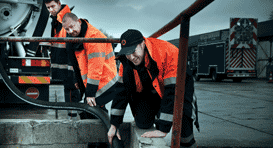What does the Civil Protection do?
 The Civil Protection renders assistance to the population when minor and major disasters occur. She provides reinforcement to emergency services with heavy and specialized equipment. The Civil Protection in Belgium comprises 450 professionals and 650 volunteers that are available 24h/24, 365 days a year. They work in six operational units that are scattered on the Belgian territory.
The Civil Protection renders assistance to the population when minor and major disasters occur. She provides reinforcement to emergency services with heavy and specialized equipment. The Civil Protection in Belgium comprises 450 professionals and 650 volunteers that are available 24h/24, 365 days a year. They work in six operational units that are scattered on the Belgian territory.
The Civil Protection is part of the Directorate-General Civil Security of the Federal Public Service Home Affairs. She intervenes at the request of the minister of Home Affairs, the governors, the mayors, the fire departments or the police.
Interventions
In 2003 the assignment of tasks between the fire departments and the Civil Protection in Belgium was fixed. A few examples of the interventions of the Civil Protection are:
- Reinforcement of the water and foam supply, or heavy, specialized equipment in case of fire
- Shore up, apply canvasses, track and rescue victims of disasters or major accidents
- Deployment of specialized teams such as diving teams or dog teams during interventions or judicial missions of long duration
- Cleaning and transport of large-scale pollution such as petrol, asphalt, …
- Decontamination and reception of the population in case of chemical or nuclear pollution
- Sealing of dikes and pumping in case of large-scale floods
- Distribution of potable water
- Support with means of telecommunication
Statistics interventions
| Type of intervention | 2011 | 2012 | 2013 | Man-hours 2013 (professionals + volunteers) | % |
| Fire | 286 | 323 | 300 | 9236,45 | 12% |
| Pollution | 955 | 1068 | 907 | 9667,27 | 13% |
| Floods | 473 | 166 | 111 | 2675,20 | 4% |
| Water distribution | 689 | 391 | 169 | 1669,42 | 2% |
Road accident | 174 | 232 | 442 | 12016,48 | 16% |
| Falling down of a building | 63 | 71 | 65 | 804,58 | 1% |
| Explosion | 14 | 14 | 9 | 254,30 | 0% |
| Storm | 44 | 66 | 131 | 2542,00 | 3% |
| Deployment of divers | 73 | 151 | 150 | 4602,02 | 6% |
| Bomb alert | 3 | 2 | 1 | 2,50 | 0% |
| Destruction of wasps' nests | 50 | 36 | 25 | 25,83 | 0% |
Transport - works | 369 | 208 | 355 | 3479,47 | 5% |
| Humanitarian | 60 | 71 | 62 | 5333,32 | 7% |
| Prevention intervention | 35 | 45 | 39 | 1683,28 | 2% |
| Logistics | 189 | 181 | 131 | 2874,73 | 4% |
| Exhibition - demonstration - exercise | 92 | 100 | 82 | 4495,07 | 6% |
| (Judicial) tracing | 153 | 142 | 159 | 4553,02 | 6% |
| Traffic signs - demarcation | 5 | 44 | 83 | 591,17 | 1% |
| Suspicious parcel | 20 | 38 | 42 | 280,60 | 0% |
Other | 288 | 263 | 336 | 7216,50 | 10% |
| TOTAL | 4035 | 3612 | 3599 | 74003,00 | 100% |
Equipment
The strength of the Civil Protection lies amongst other things in the heavy, specialized equipment that can be deployed for her own interventions, as well as for the reinforcement of the interventions of other emergency services. A few example of this equipment are:
- super cannon: to extinguish heavy fires in chemical companies.
- goliath pump: can pump away very large amounts of water with a speed of 66000 litres per minute, for instance in case of floods.
- decontamination units: to decontaminate people that became contaminated during a nuclear or chemical accident.
- vacuum tank: to quickly drain off and transport dangerous substances after for instance oil pollution in a river or ditch.
- waterline: can create up to 600 water bags per hour.
Specialized teams
A second strength lies in the specialized teams such as:
- emergency teams with dogs: track people who are buried under the rubble
- GRIMP (group for rescue and intervention at difficult places),
- USAR (Urban Search And Rescue)
- Diving teams
- IBIS teams (specialized in tracking diseased persons, mainly in cooperation with the Disaster Victim Identification team (DVI) of the federal police)
On the request of the minister of Home Affairs, agents of the Civil Protection also regularly take part in international missions. Together with people from the fire departments, medical relief workers and communication experts of Defence, they then form a “B-FAST team”. B-FAST is sent to disaster areas abroad when the stricken countries cannot offer the necessary assistance after for instance floods or earthquakes. In 2010 for example a B-FAST team was sent after the earthquake in Haiti.

